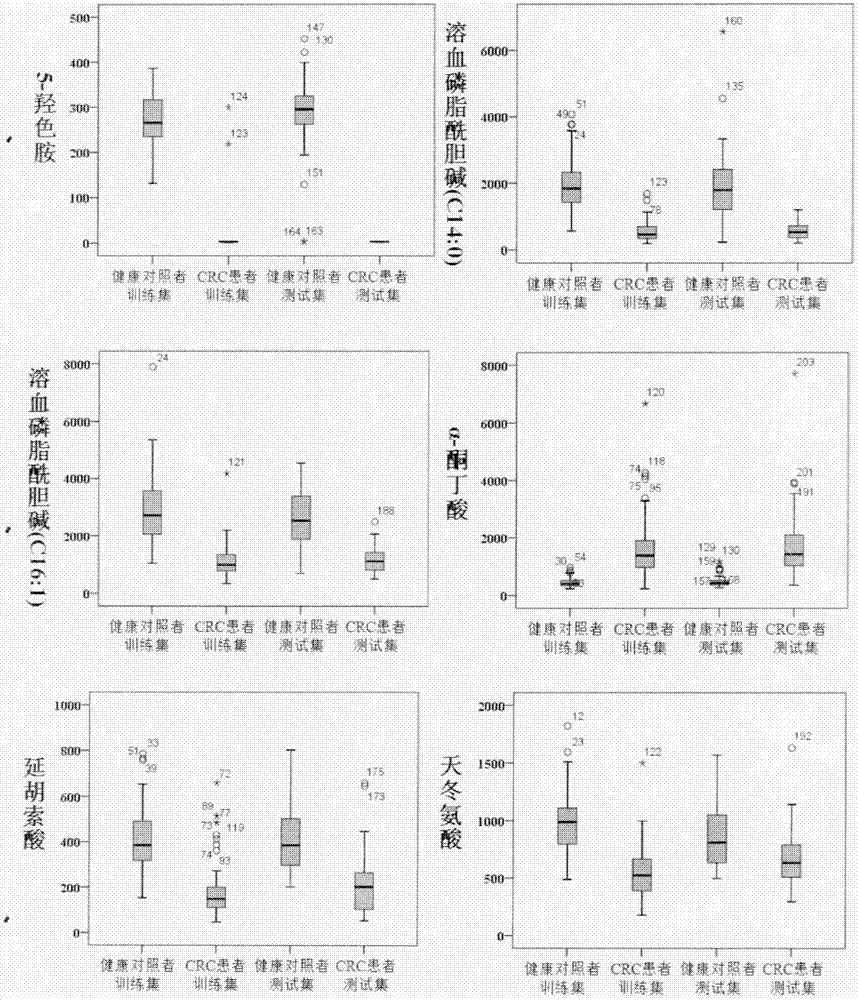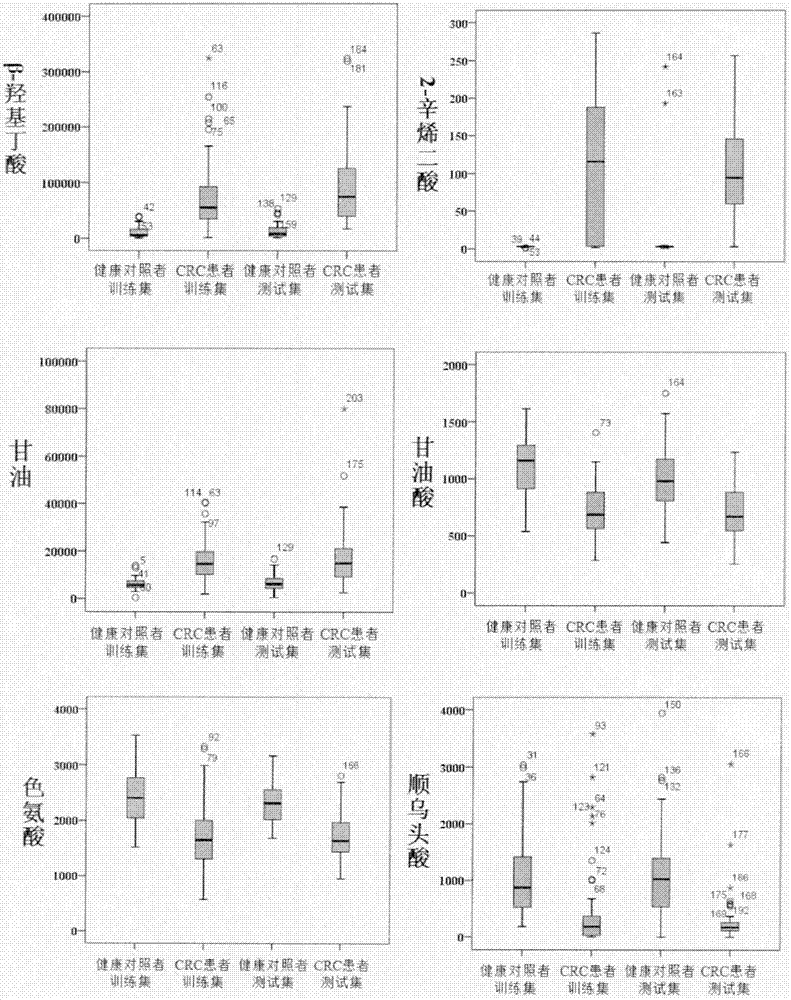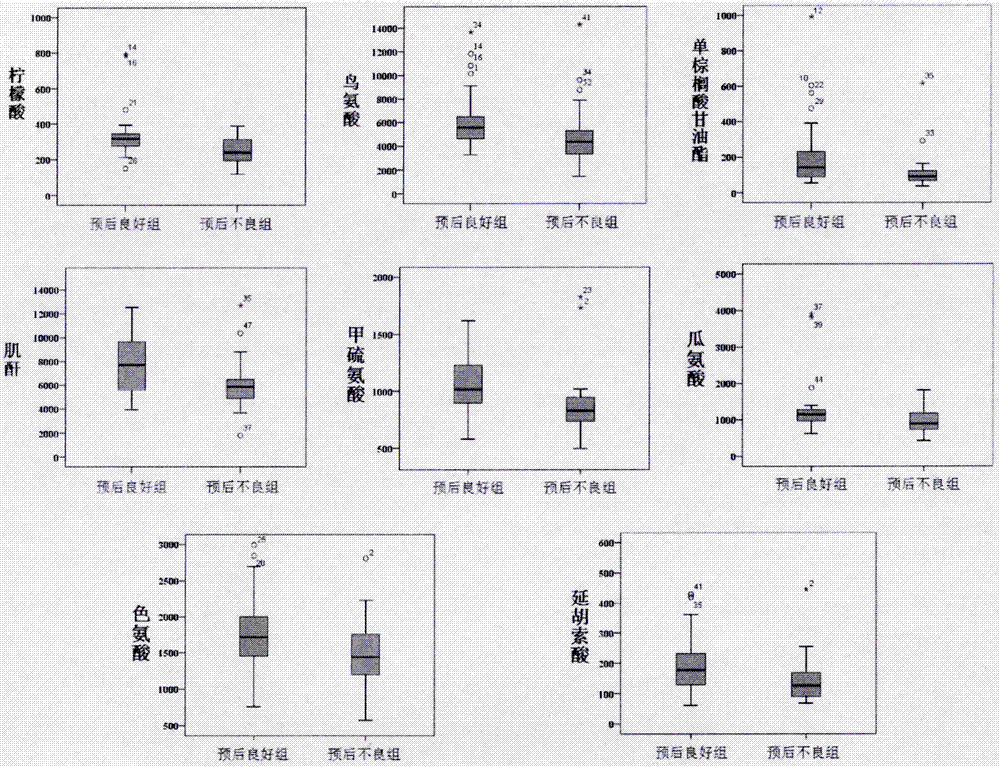Molecular marker with auxiliary functions of early diagnosis and prognosis monitoring on colorectal cancer, and application thereof
A technology of colorectal cancer and metabolic markers, applied in the field of biological detection, can solve the problems of high missed diagnosis rate, high detection cost, difficulty in large-scale population screening, etc., and achieve the effect of improving accuracy
- Summary
- Abstract
- Description
- Claims
- Application Information
AI Technical Summary
Problems solved by technology
Method used
Image
Examples
Embodiment 1
[0046] Example 1 Screening of differential metabolic markers based on GC-TOF-MS and UPLC-Q-TOF-MS platforms
[0047] 1. Sampling
[0048] Clinical sample 1: Serum from 101 colorectal cancer patients (CRC patients) and 102 healthy controls were collected, numbered and stored in a -80°C refrigerator. The samples of colorectal cancer patients came from the inpatients of Ruijin Hospital Affiliated to Shanghai Jiaotong University, and the samples of the healthy control group came from the physical examination center of Ruijin Hospital Affiliated to Shanghai Jiaotong University. 62 colorectal cancer patients and 62 healthy controls were randomly selected as the training sample set, and the remaining 39 colorectal cancer patients and 40 healthy controls were selected as the test sample set. The relevant clinical information is shown in Table 1. All clinical samples of the present invention have been approved by the Ethics Committee of Ruijin Hospital Affiliated to Shanghai Jiao Tong...
Embodiment 2
[0102] Example 2 ROC Analysis of Metabolic Diagnostic Markers Clinically Distinguishing CRC Patients and Healthy People
[0103] 1. Sampling
[0104] Sample collection is the same as clinical sample 1 in Example 1.
[0105] 2. Serum sample pretreatment and detection
[0106] Serum processing and detection methods are the same as in Example 1.
[0107] 3. Data processing
[0108] Data processing method is also the same as embodiment 1
[0109] 4. ROC analysis
[0110] 1. ROC analysis of β-hydroxybutyric acid
[0111] The statistical analysis software SPSS (v19, IBM, USA) was used for ROC analysis. The result is as image 3 Shown: In the training sample set and the test sample set, the area under the curve (AUC value) of using serum β-hydroxybutyric acid level to distinguish CRC patients and healthy people is as high as 0.925 and 0.951, respectively, and its diagnostic sensitivity is higher than that of 90%, and the specificity is over 80%.
[0112] 2. ROC analysis of 1...
Embodiment 3
[0115] Example 3 Analysis of metabolic markers in colorectal cancer patients with different pathological stages
[0116] 1. Sampling
[0117] Sample collection is the same as clinical sample 1 in Example 1.
[0118] 2. Serum sample pretreatment and detection
[0119] Serum processing and detection methods are the same as in Example 1.
[0120] 3. Data processing
[0121] Data processing method is also the same as embodiment 1.
[0122] 4. According to the analysis of clinicopathological data, fumaric acid decreases successively with the increase of pathological severity (stage I → stage IV) (such as Figure 5 shown), and there was a significant difference (p=0.03) between early patients (stage I + stage II) and advanced patients (stage III + stage IV). Serum β-hydroxybutyric acid has been significantly increased in early CRC patients, and it increases sequentially with the increase of pathological severity (stage I → stage IV) (such as Figure 6 shown).
PUM
 Login to View More
Login to View More Abstract
Description
Claims
Application Information
 Login to View More
Login to View More - R&D
- Intellectual Property
- Life Sciences
- Materials
- Tech Scout
- Unparalleled Data Quality
- Higher Quality Content
- 60% Fewer Hallucinations
Browse by: Latest US Patents, China's latest patents, Technical Efficacy Thesaurus, Application Domain, Technology Topic, Popular Technical Reports.
© 2025 PatSnap. All rights reserved.Legal|Privacy policy|Modern Slavery Act Transparency Statement|Sitemap|About US| Contact US: help@patsnap.com



